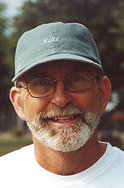 |

Tennis Anyone
July 1996
Article
Contact John Mills
Latest Tennis Anyone Article
Tennis Anyone Archives:
2003 - Present
1994 - 2002
Tennis Server
HOME PAGE
Do You Want To Be A Better Tennis Player? Then Sign Up For A Free Subscription to the Tennis Server INTERACTIVE
E-mail Newsletter!
 You will join 13,000 other subscribers in receiving news of updates to the Tennis Server along with monthly tennis tips from tennis pro Tom Veneziano.
You will join 13,000 other subscribers in receiving news of updates to the Tennis Server along with monthly tennis tips from tennis pro Tom Veneziano.
Best of all, it is free!
|
 |
TENNIS FEATURES: |
 |
TENNIS COMMUNITY: |
 |
EXPLORE THE TENNIS NET: |
|
 | |

 |
Expanding Your Service Repertoire

John Mills, USPTA |
All tennis pros have a repertoire of serves, just like baseball pitchers have
different pitches. Pros have a minimum of four target areas for their serves:
- Wide - about 4 to 6 feet short of the service line, along the sideline
- Corner - on the deuce court, to a right-handed returner's forehand, and on
the ad court to a right-hander's backhand
- Body
- Down the Middle - along the centerline.
Some pros get more specific than these four, but all of them have at least
these targets in their arsenal. Additionally, pros can hit different types of
serves to each target area. The fundamental serves all pros can hit are:
- Flat - no one hits this serve on the pro tour very often. It has no
movement, other than forward velocity, and is an easy ball to return by all
pro players. Interestingly, this serve is used as a change-up to fool a
returner who was expecting something else. If, like most recreational
players, the pros used flat serves more often, they would be eaten alive.
- Slice - recreational players generally don't have a clue as to what slice is.
Here is the difference. A pro will hit a slice so that it rotates
principally sideways, that is from 9 o'clock to 3 o'clock. The path of the
serve is an ace, from right to left before the bounce, and most importantly,
after the bounce as well. A pro's slice serve to the corner on the deuce
court will hit the side fence before it hits the back fence. Recreational
players can produce the sideways arc before the bounce, but almost without
exception, the ball bounces either up or in the opposite direction of the
bounce. This is because the spin is not 9 o'clock to 3 o'clock, but rather 8
o'clock to 2 o'clock or 7 o'clock to 1 o'clock.
- Kick - this is the serve that made Stefan Edberg famous. Huge topspin drives
the ball into the court, making it actually pick up speed after the bounce,
rebounding hard and high in the returner's face or over a shoulder - making it
very hard to return. Most recreational players will move way back returning
it on the fall. All pros must hit it on the rise. Serve & volleyers like
this serve because its high arc through the air before the bounce gives them
more time to get closer to the net. It's also a very "safe" serve with a good
rate of success of landing in the box. Like a topspin groundstroke, it
vigorously seeks the court. Your goal is to keep the returner off balance.
You simply cannot depend on being able to overwhelm an opponent with pace.
There are many variations of these fundamentals, and even some types of serves
that bear no resemblance to what I have just outlined. But you should know
what the fundamentals of hi-level serving are. You, like the rest of us, have
plenty to work on for the next 10 years. Good luck!
  
Tennis Anyone Archives:
1994 - 2002 | 2003 - Present
If you have not already signed up to receive our free e-mail
newsletter Tennis Server INTERACTIVE, you can sign up here.
You will receive notification each month of changes at the Tennis
Server and news of new columns posted on our site.
|
This column is copyrighted by John Mills, all rights reserved.
John Mills' experience includes four years as head pro at the Windemere Racquet & Swim Club, where he was responsible for organization of all tennis activities at the club. John also played college tennis at the University of Houston and has spent 20 years teaching tennis at the Memorial Park Tennis Center, the Pasadena Racquet Club, and as the head pro at the Bay Area Racquet Club.
|
 |
|

|





 You will join 13,000 other subscribers in receiving news of updates to the Tennis Server along with monthly tennis tips from tennis pro Tom Veneziano.
You will join 13,000 other subscribers in receiving news of updates to the Tennis Server along with monthly tennis tips from tennis pro Tom Veneziano. 